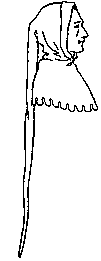

Head-coverings were a common necessity during the Middle Ages in Europe. Based upon contemporary illustrations of the period and surviving examples chaperons seemed to be worn by all classes of society and were tailored in quite a number of different styles and forms. The peak of the hood grew so long that it hung to the floor, requiring knots to be tied in it. This appendage became known as the "liripipe" and was often wound about the head with the end tucked in, or draped across the shoulders. The bottom edge of the shoulder cape was dagged or straight hem draping down to the elbows or just covering the shoulders. The chaperon was pulled over the head, buttoned up the front or fastened closed with a pin at the collar. A dukes’ chaperon could be distinguished from that of a peasants by the extreme costliness of material used, the ornateness of the dagging, or the excessive length of the liripipe.

Towards the end of the 14th century the chaperon began to be worn as extravagant hat by rolling the face-opening up as a brim and placing it on the head with the liripipe wrapped around the head like a turban, with the gorget (the shoulder cape) draped to one side of the head. However by the turn 15th century a new style of the “hooded-turban” appeared. Instead of the gorget draping to one side of the head it was made of a stiffer material that would make it stand up on the head when worn and since most were dagged by this time it gave the appearance of a cock’s comb.

|
|
Standard Disclaimer